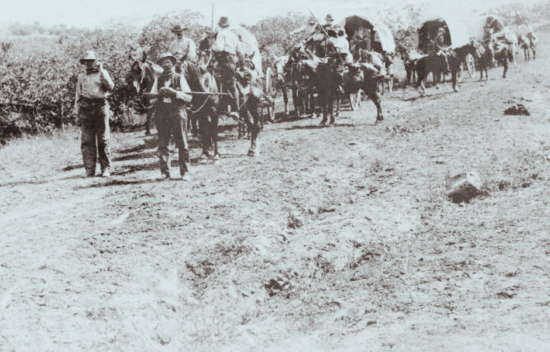
Voices From Western Expansion
Guiding Questions
- How did the acquisition of new territories impact the nation’s growth and development?
- How did westward expansion impact Native American tribes, and what were the consequences of these interactions?
Objectives
- Students will understand the experiences of Americans who settled out West.
- Students will understand the impact that western expansion had on Native Americans.
Facilitation Notes
This lesson will help students better understand the experiences during time of western expansion through assessing primary sources.
Anticipate (Optional)
- Quick Write: Ask students to spend 3 minutes writing about what they think daily life was like for pioneers and Native Americans during the time of western expansion.
- Think-Pair-Share: Have students share their ideas with a partner, then invite a few pairs to share with the class.
Engage
- Display the image Mormon Pioneers, 1847
- Link: https://www.loc.gov/resource/cph.3c13103/
- Conduct a See-Think-Wonder (STW) activity:
- What do you see? (Observations)
- What do you think about that? (Interpretations)
- What does it make you wonder? (Questions)
- See-Think-Wonder Options
- Model the STW process by thinking aloud:
- See: “I am going to describe exactly what I observe in this image without making any interpretations.”
- Example: “I see people in wagons. They are walking along a path. This is in black and white.”
- Think: “Now, I will share what I think about what I am seeing, based on my observations and prior knowledge. I am also going to consider what civic virtues might be demonstrated in this image.”
Scaffolding note: Civic virtues are good habits that promote self-government and help guarantee that communities orient themselves towards advancing the spirit of a common purpose. See our list of civic virtues. An example of a virtue depicted in the photo is courage.
- Example: “I think this might be pioneers because of the covered wagons.”
- Wonder: “Finally, I will ask questions about what I have observed and thought about.”
- Example: “I wonder where this trail is. I wonder why these people are traveling on the trail.”
- Student Pair/Group Activity:
- Divide students into pairs or small groups.
- Instruct students to complete the STW process together, recording their ideas in each column of the graphic organizer
- Circulate to provide support and ask probing questions.
Scaffolding note: Consider providing students with the following thinking stems to support student analysis.
- See:
- “In this image, I notice…”
- “The photograph shows…”
- “I can clearly see…”
- “In the foreground/background, there is…”
- Think:
- “Based on what I see, I think…”
- “This image might represent…”
- “The photographer may have wanted to show…”
- “This makes me think about…”
- “This image might demonstrate the civic virtue of…”
- “The actions shown here could represent…”
- “This photograph makes me think about the importance of…”
- Wonder:
- “I wonder why…”
- “What might have happened just before/after this photo was taken?”
- “How might the people in this image be feeling?”
- “I wonder how people today might demonstrate similar civic virtues…”
- “What challenges might people have faced in upholding these virtues during westward travel?”
Explore
- Divide the class into small groups (3-5 students).
- Provide each group with a primary source related to personal experiences during western expansion.
- Jigsaw Activity:
- Assign each group member a specific primary source to analyze.
- Students record information about their source on their graphic organizer. Then they use the information to create a visual display summarizing their primary source and key takeaways. The visual display can be done on paper or a digital tool of choice. Below are detailed questions to help guide students when using the graphic organizer.
- Voice: What is the author’s voice? What is their job, age, class, etc. and how might it impact what they are saying?
- Intent: Is the document intended to inform, persuade, remind, change?
- Environment: What is the environment like surrounding the creation of the document? What had happened before the document was created?
- Who: Who was the document created for? Was it written for a friend or foe in the form of a letter? Is it a diary entry that was probably just for individual memory keeping?
- Key details about personal experiences including evidence of civic virtues
- Questions about the source
- Gallery Walk:
- If the group visual displays were done on paper, groups rotate around the room, viewing other groups’ displays.
- Students use sticky notes to leave comments or questions on other groups’ work.
- If the visual displays were completed digitally, groups should review the other displays together on their devices.
- Have students use the comment feature on the chosen digital tool to interact with other groups by leaving comments or questions.
- Students should record information about the other primary sources on their graphic organizer.
Assess & Reflect
- Individual Reflection
- Students write a short paragraph answering the question:
- After looking at these primary sources, what did you learn about what life was like for people during westward expansion?
- Students write a short paragraph answering the question:
- Class Discussion:
- What did you notice about the different experiences people had during westward expansion? What was similar? What was different?
- What was challenging about understanding the primary sources?
- How did these personal stories help you learn about what life was really like during this time?
- Why is it important to learn about history through real people’s experiences, not just big events or facts?
AND/OR
- Exit Ticket
- Students write one new question they have about life for pioneers/Native Americans during western expansion based on their exploration of the primary sources.